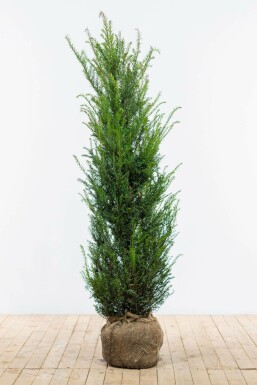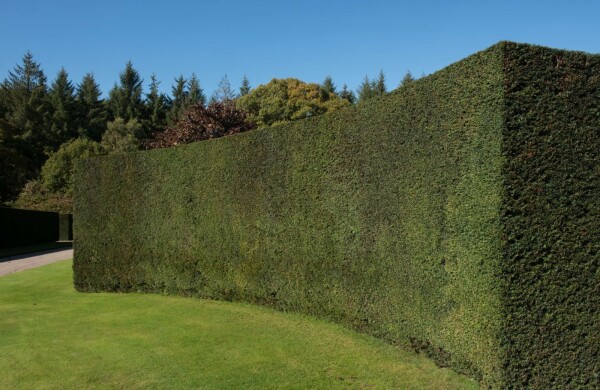


60-80

3
At Heijnen Plants, we take pride in offering the esteemed Taxus baccata, known to many as the common yew or English yew. This distinguished conifer is celebrated for its dense, dark-green foliage and its ability to form an elegant, formal hedge. The yew's small, inconspicuous flowers, which bloom in yellow and green, are a subtle highlight, complementing its year-round appeal. Native to regions including Europe, Western Asia, and North Africa, Taxus baccata is a timeless choice for gardeners seeking a touch of classic elegance and enduring charm.
































Taxus baccata, widely known as the common yew or English yew, is a remarkably adaptable and long-lived conifer. This species has an iconic place in garden and landscape design due to its dense foliage and elegant, dark green needles. It is a top choice for creating lush hedges and topiaries, but it also stands out as a solitary plant with its stately presence.
By following these tips, your Taxus baccata will remain a vibrant and robust feature in your garden for years to come.
We would like to provide some tips on how to plant and care for a Taxus. By following these tips, you can be sure to enjoy your Taxus for a long time.
For optimal growth, the English yew tree thrives in a range of light conditions, from full sun to partial shade and even full shade, making it a versatile choice for many garden settings. It is essential that the soil is well-drained to prevent waterlogging, which could adversely affect the plant's health. This species is hardy, tolerating temperatures as low as -17.8°C, aligning with USDA zone 6 climates. While it can adapt to various soil types, ensuring the ground is well-prepared and not prone to drought is key to its successful cultivation.
For successful establishment, ensure that the planting site for Taxus baccata is well-prepared with well-drained soil, as it is tolerant of a wide range of soil types. Planting should be done when the ground is not frozen, ideally between late autumn and early spring. The root ball should be placed into a hole that is wider than it is deep, allowing for ample space for root expansion. Once positioned, backfill with the excavated soil, pressing down firmly to eliminate air pockets. Water thoroughly after planting to settle the soil around the root ball and continue to provide adequate moisture, especially during dry spells.
To maintain the dense and formal appearance of Taxus baccata as a hedge, pruning should occur twice annually. The first trim should be in late spring after new growth has hardened, typically around June, and the second in late summer, around August. It is essential to shape the hedge so that it is wider at the base than at the top to allow light to reach the lower branches and prevent the base from thinning out. Use sharp shears and make clean cuts to promote healthy regrowth.
The Taxus baccata tree has a moderate tolerance to dry conditions but should not be exposed to prolonged drought. Regular watering during dry spells is crucial to maintain its vibrant green foliage. A deep watering routine is beneficial, encouraging a strong root system that can sustain the plant through varying weather conditions. It is particularly important to ensure that the root ball is well-hydrated, especially after planting and during the establishment phase. During winter, the plant's water requirements diminish, but it's essential to prevent the soil from completely drying out.
For optimal health and dense foliage of the English yew hedge, a balanced approach to nutrition is essential. Fertilize in early spring and again in mid-autumn to support vigorous growth and the rich green color that is characteristic of Taxus baccata hedge. Utilize a complete granular fertilizer, which includes both macro and micro-nutrients to ensure a robust root system and strong plant structure.
The granules should be spread evenly around the drip line of the hedge, not against the trunk or stems, to prevent burning and ensure the roots can access the nutrients. As these hedges are evergreen and maintain their foliage year-round, consistent fertilization is key to sustaining their visual density and hardiness, especially in preparation for the winter months.
One often overlooked attribute of baccata is its exceptional tolerance to pruning, allowing it to be sculpted into various forms without compromising its robust vigor. The dense, evergreen foliage provides year-round structure and color to gardens. Additionally, when planted in groups, this species can form a lush, impenetrable hedge, offering privacy and a haven for wildlife. The root ball establishment promotes a healthy root system, ensuring a strong foundation for the plant to thrive for years to come.
Elevate your landscape with the distinguished Taxus baccata, a timeless classic among conifers. Revered for its lush, dark green foliage, this distinguished plant is a testament to elegance, offering a stately presence in any garden setting. Ideal for topiary or a dignified hedge, it embodies both beauty and resilience.
